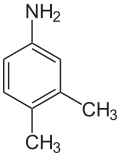 | |
| Names | |
|---|---|
| Preferred IUPAC name 3,4-Dimethylaniline | |
| Other names
3,4-Dimethylphenylamine 3,4-Dimethylbenzenamine | |
| Identifiers | |
| CAS Number | |
| 3D model (JSmol) | |
| ChEBI | |
| ChemSpider | |
| ECHA InfoCard | 100.002.217 |
| PubChem CID | |
| UNII | |
| CompTox Dashboard (EPA) | |
InChI
| |
SMILES
| |
| Properties | |
| Chemical formula | C8H11N |
| Molar mass | 121.183 g·mol |
| Melting point | 51.0 °C (123.8 °F; 324.1 K) |
| Boiling point | 226.0 °C (438.8 °F; 499.1 K) |
| Except where otherwise noted, data are given for materials in their standard state (at 25 °C , 100 kPa).
| |
3,4-Xylidine is an organic compound with the formula C6H3(CH3)2NH2. It is one of several isomeric xylidines. It is a colorless solid. It is a precursor for the production of riboflavin (vitamin B2).
The compound is prepared by two routes: hydrogenation of (2-chloromethyl)-4-nitrotoluene and reaction of the bromoxylene with ammonia.
Safety
Like other xylidines, 3,4-xylidine has modest toxicity with an LD50 of 812 mg/kg when administered orally to rats.
In 2003, more than twenty US Army troops were allegedly exposed to 3,4-xylidine during the occupation of Iraq, leading to a number of health complaints.
References
- ^ M. Meyer (2012). "Xylidines". Ullmann's Encyclopedia of Industrial Chemistry. Weinheim: Wiley-VCH. doi:10.1002/14356007.a28_455. ISBN 978-3527306732.
- "12 Years Later, a Mystery of Chemical Exposure in Iraq Clears Slightly". New York Times. May 14, 2015.